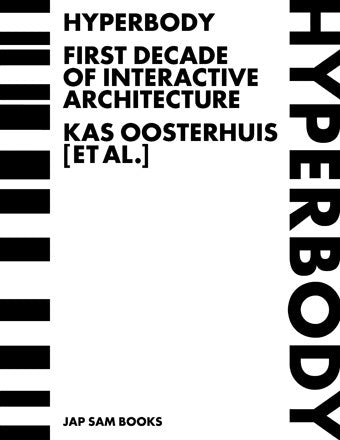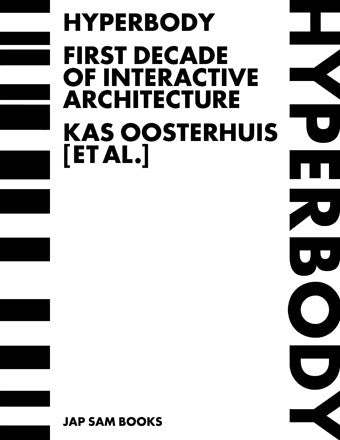Your cart is currently empty!
Theory
Hyperbody
+++First Decade of Interactive Architecture+++
+++Kas Oosterhuis [et al.]+++
978-94-90322-09-0
Mind Design (Niels Schrader, Michal Ejdys m.m.v. Erik Boldt, Gilles de Brock, Fernando van der Vlist)
624
24 x 17
Paperback
English
Date of release: June 2012
Awarded one of the Best Dutch Book Designs 2012. For more information: www.bestverzorgdeboeken.nl
HYPERBODY, directed by Prof. Kas Oosterhuis, is an information technology driven research and design group operating within the Faculty of Architecture, Delft University of Technology. The group is at the forefront in the development of computationally driven non-standard and interactive architecture, which is parametrically actuated by users and their immediate environment. Interactive, non-standard architecture and urbanism is seen as an active, component-based system that reflects contemporary social and spatial reality.
HYPERBODY explores interdisciplinary spatial domains via specific practices and academic collaborations in order to develop in-house cutting-edge design tools, techniques and methods for the making of complex non-standard, customized, interactive architectures. HYPERBODY's architecture is based on swarm theory, wherein the built environment is defined as a space that is formed and informed by smart components that interact with each other and users like birds interact in a swarm. Such interactions have been developed and tested in the protoSPACE laboratory, which is operated by HYPERBODY within the larger Internet of Things and People.
HYPERBODY explores digital manufacturing using in-house large industrial robots, laser cutting and rapid prototyping facilities in order to physically construct, analyse and engineer complex parametric building components and their mutual interconnections. HYPERBODY's vision in today's mediated context is geared towards developing strategic design methodologies in order to propagate socially, environmentally and economically performative design solutions and to demonstrate their buildability by developing 1:1 prototypes.
The Hyperbody publication, designed by concept-driven graphic designer Niels Schrader, takes its title literally, as it presents the content in the form of a non-sequential hyper-structure. A network of references connects related pieces of information, and offers the reader the opportunity to instantly jump to other sections in the book. The hyperlinks were established by proprietary software that first scanned the entire content of the book and listed the most frequent keywords for each page. A maximum of 3 words from this page-specific list is then used to find semantically related texts on other pages and create the ultimate interactive reading experience: flipping back and forth between passages of different authors, cross-checking and comparing them.
First Decade of Interactive Architecture
€40.00
Hyperbody
First Decade of Interactive Architecture
€40.00
Architecture / Awarded / Design / Theory
978-94-90322-09-0
Mind Design (Niels Schrader, Michal Ejdys m.m.v. Erik Boldt, Gilles de Brock, Fernando van der Vlist)
624
24 x 17
Paperback
English
Date of release: June 2012
Awarded one of the Best Dutch Book Designs 2012. For more information: www.bestverzorgdeboeken.nl
HYPERBODY, directed by Prof. Kas Oosterhuis, is an information technology driven research and design group operating within the Faculty of Architecture, Delft University of Technology. The group is at the forefront in the development of computationally driven non-standard and interactive architecture, which is parametrically actuated by users and their immediate environment. Interactive, non-standard architecture and urbanism is seen as an active, component-based system that reflects contemporary social and spatial reality.
HYPERBODY explores interdisciplinary spatial domains via specific practices and academic collaborations in order to develop in-house cutting-edge design tools, techniques and methods for the making of complex non-standard, customized, interactive architectures. HYPERBODY's architecture is based on swarm theory, wherein the built environment is defined as a space that is formed and informed by smart components that interact with each other and users like birds interact in a swarm. Such interactions have been developed and tested in the protoSPACE laboratory, which is operated by HYPERBODY within the larger Internet of Things and People.
HYPERBODY explores digital manufacturing using in-house large industrial robots, laser cutting and rapid prototyping facilities in order to physically construct, analyse and engineer complex parametric building components and their mutual interconnections. HYPERBODY's vision in today's mediated context is geared towards developing strategic design methodologies in order to propagate socially, environmentally and economically performative design solutions and to demonstrate their buildability by developing 1:1 prototypes.
The Hyperbody publication, designed by concept-driven graphic designer Niels Schrader, takes its title literally, as it presents the content in the form of a non-sequential hyper-structure. A network of references connects related pieces of information, and offers the reader the opportunity to instantly jump to other sections in the book. The hyperlinks were established by proprietary software that first scanned the entire content of the book and listed the most frequent keywords for each page. A maximum of 3 words from this page-specific list is then used to find semantically related texts on other pages and create the ultimate interactive reading experience: flipping back and forth between passages of different authors, cross-checking and comparing them.



















